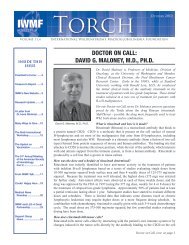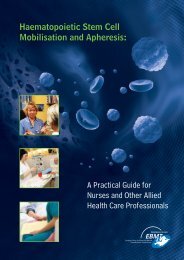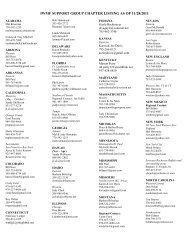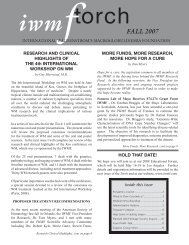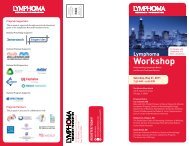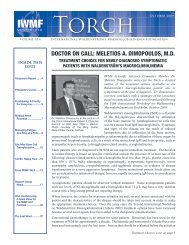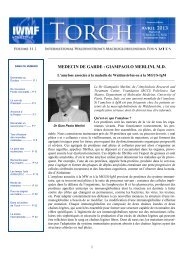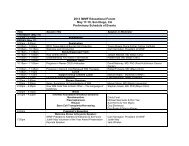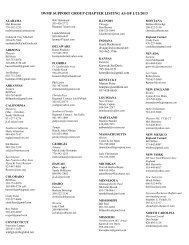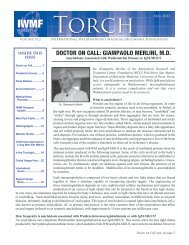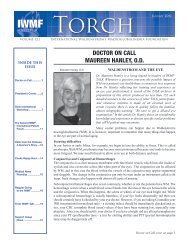English - International Waldenstrom's Macroglobulinemia Foundation
English - International Waldenstrom's Macroglobulinemia Foundation
English - International Waldenstrom's Macroglobulinemia Foundation
Create successful ePaper yourself
Turn your PDF publications into a flip-book with our unique Google optimized e-Paper software.
Highlights of ASH 2009, cont. from page 7<br />
event I attended. The research presented indicates that, in the<br />
very near future, lymphoma and other hematological cancer<br />
patients will have some of their circulating immune system<br />
cells harvested (much like a stem cell harvest) and that<br />
these harvested cells (predominantly T-cells) will, in turn, be<br />
grown in the lab, amplified in numbers and in their cancer<br />
fighting capabilities, and returned to the patient to assist in<br />
the treatment of the patient’s cancer. This process is already<br />
being done to great effect in bone marrow transplant patients,<br />
and it is expected that similar techniques can be used to boost<br />
patient response to immunotherapeutic drugs like rituximab.<br />
Perhaps we can envision the day when we not only receive an<br />
infusion of rituximab but also an infusion of large numbers of<br />
killer T-cells to increase the effectiveness of the monoclonal<br />
antibody treatment.<br />
Speaking of monoclonal antibodies, it is now quite clear<br />
that the addition of rituximab to many combinations of<br />
“traditional” chemotherapeutic agents – cyclophosphamide,<br />
fludarabine, bortezomib, CHOP – significantly enhances<br />
rate of response and survival. The trial results of a new<br />
drug, ofatumumab (GlaxoSmithKline), that works in<br />
manner similar to the anti-CD20 monoclonal antibody<br />
rituximab (Rituxan, Genentech/Roche), were reported at<br />
the meeting as an example of monoclonal antibodies used<br />
in immunotherapy for lymphoma. The trial in previously<br />
untreated patients with chronic lymphocytic leukemia<br />
(CLL) showed that ofatumumab given in combination with<br />
fludarabine and cyclophosphamide was “highly active.”<br />
One researcher commented that ofatumumab monotherapy<br />
was not a viable treatment option in patients with follicular<br />
lymphoma unresponsive to rituximab. In 116 patients who<br />
failed to achieve at least a partial response to rituximab –<br />
used either alone or with chemotherapy – objective responses<br />
occurred in only 11% of those taking ofatumumab. The<br />
same researcher noted, however, that the response was<br />
higher – 22% – in a subgroup of patients who had failed<br />
rituximab monotherapy. A clinical trial with ofatumumab in<br />
WM is currently underway. Yet another agent, GA 101 from<br />
Genentech, has been dubbed “son of rituximab” and is being<br />
investigated in relapsed/refractory CLL.<br />
In the case of patients with indolent lymphoma (such as<br />
WM) whose disease has progressed after treatment with<br />
rituximab, another study indicated that long-term survival<br />
can still be achieved if the patients are switched to the<br />
radioimmunoconjugate Bexxar (Iodine-131 tositumomab).<br />
Median overall survival was 6.7 years after receiving Bexxar.<br />
In the area of cancer vaccines, a new protocol for treating<br />
low-grade B-cell lymphomas with Rituxan (rituximab) and<br />
tumor-specific vaccination was presented that appears to<br />
increase response rates and time to progression over Rituxan<br />
alone. In a clinical trial of patients with follicular B-cell non-<br />
Hodgkin’s lymphoma, Rituxan followed by vaccination with<br />
an antibody directed against a lymphoma-specific tumor<br />
idiotype resulted in a 64% overall response rate compared<br />
with Rituxan alone. The use of rituximab followed by<br />
vaccination may change the natural course of the disease<br />
and is obviously very attractive for the patient as it does not<br />
include chemotherapy.<br />
Insofar as the traditional chemotherapeutic regimens are<br />
concerned, results from a Phase III study demonstrated that<br />
the combination of rituximab and bendamustine (Treanda) in<br />
the first-line treatment of patients with advanced follicular and<br />
indolent lymphomas resulted in better outcomes than the “gold<br />
standard” of R-CHOP (rituximab plus cyclophosphamide,<br />
doxorubicin, vincristine [Oncovin] and prednisone).<br />
Bendamustine is an old drug that was used more than thirty<br />
years ago in Germany. This new study used first-line treatment<br />
with bendamustine in B-cell non-Hodgkin’s lymphoma, and<br />
the results showed improved progression-free survival and<br />
tolerability. These new data for bendamustine have already<br />
impacted clinical practice in NHL, including WM.<br />
Of interest to some WM’ers is the relationship between<br />
cholesterol, the use of cholesterol-lowering drugs (statins<br />
in particular) and lymphomas. In New Orleans researchers<br />
reported that patients who are already taking statins to reduce<br />
cholesterol at time of diagnosis with CLL may be less likely<br />
to need treatment for the cancer. The researchers believe that<br />
lipid biology is important in CLL progression. Whether this<br />
applies to WM remains to be seen.<br />
There were some interesting presentations in the area of<br />
complementary/integrative medicine. The medical director<br />
of the Center for Integrative Therapies at the Dana-Farber<br />
Cancer Institute reflected that a patient once told him:<br />
“I may be receiving the best therapy in the world, but you<br />
are not treating me as a whole human being.” Current<br />
data on integrative approaches as they pertain to children,<br />
survivorship, and supplements was presented at ASH (as is<br />
the case at virtually all cancer conferences nowadays).<br />
Finally, of great interest to me, and perhaps to some of you,<br />
a small randomized clinical trial showed that employing<br />
a simple acupressure technique significantly reduced the<br />
proportion of patients who reported severe pain during bone<br />
marrow aspiration and biopsy. The technique involved use of<br />
suction cups to apply pressure to the large intestine 4 (LI4)<br />
acupoint near the space between the thumb and forefinger.<br />
Patients treated with acupressure were 89% less likely to find<br />
the bone marrow procedure severely painful compared with<br />
patients who had sham acupressure. Bonus observation: this<br />
works with dental pain as well!<br />
In the next issue of the Torch, look for reports from the 2009<br />
ASH conference in New Orleans that are more technical<br />
and in greater depth.<br />
8 IWMF TORCH Volume 11.2



